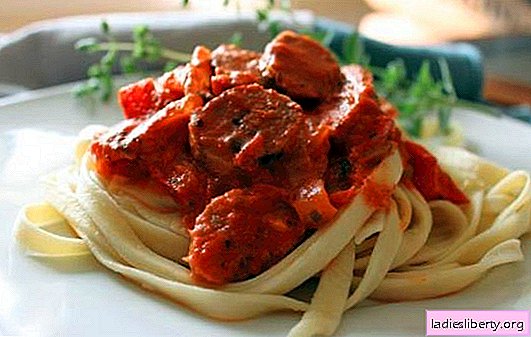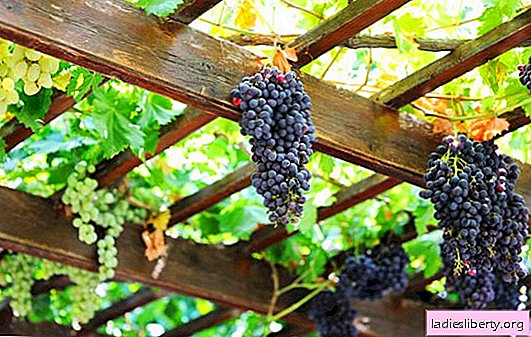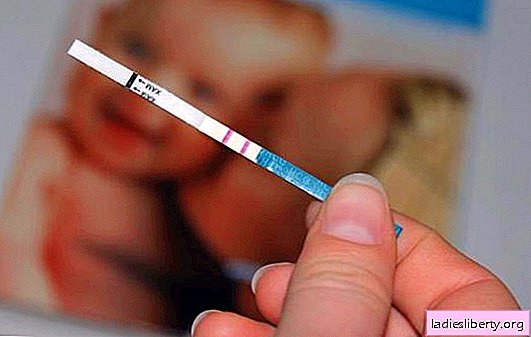
Growing Chinese cabbage is a troublesome business, even experienced gardeners often face failure.
In order for everything to work out, you need not only to properly care for the seedlings, but also to comply with the timing, as well as the rules of planting.
When to plant Beijing cabbage on seedlings and how to do it right?
When to plant Chinese cabbage for seedlings
Beijing is widely marketed, gardeners grow many varieties, but the easiest to grow is kale. It can most often be found in the market and in stores. It is a cold-resistant crop that produces a rich crop with a short daylight. The first mistake of many summer residents is the wrong landing time.

Important! When the daylight is more than 13 hours, the seedlings of cabbage rotate without forming heads. This feature is worth considering.
Due to the fact that the seeds hatch at a temperature of 4-5 C, and good head of cabbage are tied only at a temperature of 15-20 C, in some regions two crops are harvested per season. Thus, the landing of Beijing cabbage on seedlings is carried out in early spring and late summer. The exact timing depends on the growing region and climate.
• In Siberia, sowing of seeds is carried out in early March in the greenhouse or in early May in open ground. For autumn consumption, seedlings are prepared in the second half of July.
• In central Russia, seeds are sown strictly from April 15 to 20 or from August 20 to 15.
• In the southern regions of the country, Beijing is sown very early, from late March to early April. For autumn consumption, sowing is carried out from mid-August to mid-September.
When planting Beijing cabbage on seedlings, it is understandable, but a variety of culture is also important. To get a good harvest, experienced gardeners recommend growing only hybrid Beijing varieties that are resistant to flowering:
• Manoko, Orange mandarin - early ripe varieties that are harvested after 45-50 days;
• Cha-Cha, Lyubasha or Vorozheya - mid-season varieties, maturity occurs on 50-60 days;
• Nika and Russian size - late varieties, cut after 60-80 days.
In the northern regions of the country, it is better to plant early varieties, which are distinguished by their early maturity and resistance to pests. The first crop can be obtained 30-40 days after transplanting seedlings into the ground.
Advice! The age of seedlings before planting in the ground should be 30 days. This will help to accurately calculate the timing of sowing seeds of Beijing cabbage for seedlings.
How to grow seedlings of Beijing cabbage at home
The second mistake when growing Beijing cabbage is picking seedlings. It is preferable to grow seedlings without a pick, since Peking does not tolerate it well. It is better to plant the seeds not in a common container, but immediately in separate peat cups of several pieces. As the seedlings grow, the strongest is left, and the rest is removed. Transplanting seedlings to a permanent place is carried out in the same pots, while the root system is not injured.

Important! Any interference with the root system or changing the growing conditions leads to the flowering of cabbage to the detriment of the crop.
Tanks for growing seedlings are filled with loose soil mixture and seeds are planted to a depth of 1.5-2 cm. After sowing, the glasses are removed to a warm but dark place for seed swelling.
As soon as the seedlings appear, the containers are transferred to a bright but cool place where the temperature does not rise above 7-8 C. You can bring the seedlings to a glazed loggia or to an unheated room. Water the seedlings with warm water and very carefully so as not to pour.
When to plant seedlings of Chinese cabbage in open ground
If the spring is early, then you can do without growing seedlings in cups, sowing seeds directly into the open ground. In this case, the seeds are planted to a depth of 1-1.5 cm. The seed is quite large, so it will not be difficult to distribute it at a distance of at least 15-20 cm. After emergence, seedlings are thinned out every 10 cm. As soon as the plants get stronger, the shoots are thinned out again, leaving 1 seedling for every 35-40 cm.

With summer cultivation, sowing is carried out in the same way. 21 days after germination, cabbage is spudded, when the leaves are closed, the aisles are weeded. Watered sparingly, avoiding stagnation of water, but in the dry period, the soil is moistened to a depth of 20 cm.
Experienced gardeners resort to a little trick to regularly get Peking crops to the table and sow seeds every week on time. To reduce daylight hours and prevent the flowering of cabbage, the beds are covered with lutrasil.
How to transplant seedlings of Beijing cabbage in open ground
As already mentioned, seedlings are planted together with peat cups so as not to injure the roots. 10 days before the intended planting, seedlings are taken out for hardening. Before planting, they are watered well.
For a good harvest of cabbage, it is important to choose the right place so that the plant feels comfortable. Pekingka prefers sunny areas with light, fertile and well-drained soil, preferably loamy. Just do not plant cabbage after tomatoes, beets or other cruciferous crops. They have common diseases and pests. The best precursors will be legumes, siderates, carrots, onions, garlic or cucumbers.
The Beijing area is prepared in the fall or spring. Under digging make compost and humus. Superphosphate, wood ash and urea are added to each well. Planting is well watered.
How to get a large crop of Beijing cabbage in the open ground
It is important to know that the vegetable grows well only in coolness, but in good light and humidity. At first, it was recommended to cover the beds with non-woven material.
1. Young plants will receive protection against sudden frosts or heat.
2. Seedlings take root faster without access to sunlight.
3. The root system of seedlings will not suffer from waterlogging in the rainy period.
4. Beijing will be reliably protected from the cruciferous flea.
5. Cabbage under cover better forms head out.
After 14 days, the shelter is removed, and the bed is mulched with straw. Rowing aisles is carried out carefully. Further care for the vegetable does not differ from usual.
Watering
Beijing cabbage is a hygrophilous plant, so it requires copious, but rare watering. It is enough to wet the soil once a week to a depth of 20-25 cm.
Water the plant with warm water strictly under the root, so that water does not fall on the leaves. This is best done early in the morning or in the evening. The bed after watering is well mulched, which will help maintain moisture in the soil for a long time.
Top dressing
As practice shows, a good harvest of Beijing cabbage can be grown using organic fertilizers.
1. The first time planting is fertilized with a solution of bird droppings, mullein or infusion of grass. For one plant, spend up to a liter of fertilizing.
2. The second time the bed is fertilized when the forks are formed with a solution of boric acid. It is better to do top dressing on the leaves and in the evening.
Spring planting is fertilized 3 times, and autumn only two.
Growing Beijing cabbage in a greenhouse
In greenhouse conditions, Peking is grown by sowing seeds directly into the soil or through seedlings.
If you resort to the last option, then the heads of cabbage will ripen a week earlier than usual.
For proper growth, plants need optimal conditions.
The temperature regime is maintained at a level of 15-20 C, fluctuations in any direction provoke flowering and various diseases.
Humidity in the greenhouse should be at least 70%.
Problems When Growing Beijing Cabbage
To analyze the mistakes made, first of all, you need to know how Peking grows.
After the appearance of seedlings, leaves form, they close into a socket and form a head weighing 1-2 kg. Then comes the flower arrow. However, most often the flower arrow is formed earlier, the vegetable does not form forks. Why it happens? The answer is simple - Peking plant is cold-resistant, and high air temperature and long daylight hours cause flowering.

To successfully grow a vegetable in a hot southern climate is possible only in early spring or late autumn. But in the north it is much easier to implement.
The problem of growing cruciferous plants can be attributed to pests, among which flea, cabbage fly, scoop, moth, white butterfly and bear are especially bothersome.
The vegetable is unstable to diseases, most often seedlings are affected by a black leg, fungal diseases, bacteriosis and rot, powdery mildew. However, if you properly care for the plant and observe crop rotation, then these troubles will bypass.
What to do if the plant is still sick? From fungal diseases, spraying with fungicides helps, but you can not cope with viruses. Affected plants are removed from the beds, and the planting site is processed. Insecticide spraying is used against insects, but once is not enough to completely destroy the pest. Re-treatment is carried out after 7-10 days.
Important! The last processing is carried out a month before harvesting.
How to store Beijing cabbage
After harvesting, not all heads of cabbage are suitable for storage. Forks planted in spring are suitable only for summer consumption and do not lie for a long time. Autumn cabbage is successfully stored until mid-winter, sometimes longer.
Since the plant is cold-resistant, it can be left in the garden until mid-October. Only fully ripened forks, i.e. those that have gained density, need to be cleaned and stored.
Beijing does not require any special conditions for successful storage. It lies well in a dry basement, where the temperature does not rise above 5C., And the humidity is at 95%. Cabbage heads are simply laid out on wooden shelves or drawers. Some gardeners store cabbage differently, wrap each fork in cling film. In this form, it lies well until spring. Inspect vegetables more often; use spoiled first.
Experienced gardeners noticed that it is impossible to store cabbage with apples, otherwise it starts to wither early. If there is no cellar or basement, then you can put the crop on a glazed loggia, but watch the temperature so that it does not drop below 0 C. When the weather is established and the temperature in the street drops below -5 C, the heads are additionally covered with a warm blanket or burlap.
To summarize
It is not difficult to grow Beijing cabbage, and when planting it on seedlings, every gardener decides for himself. But first, determine the purpose of the crop and the variety. If you need cabbages for summer consumption, sow the seeds in early spring. Late for deadlines? It does not matter, you can plant seedlings of Beijing cabbage in the middle of summer, then in late autumn enjoy its amazing taste.
Observe crop rotation and be sure to carry out preventive treatments against pests and diseases. Take care of the plant correctly: in moderation, water, feed and a good harvest will not keep you waiting.












